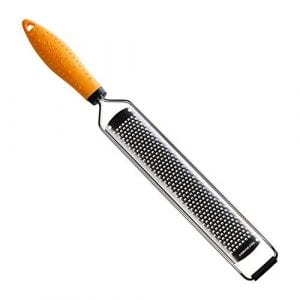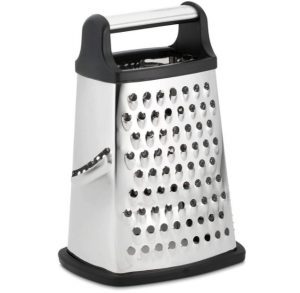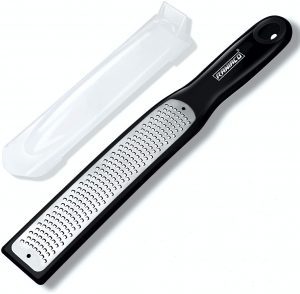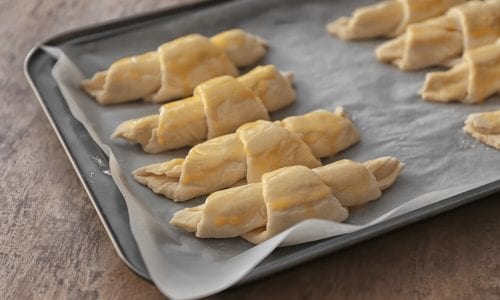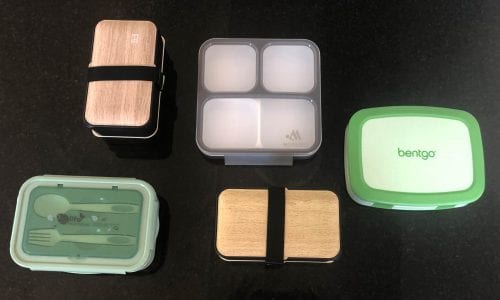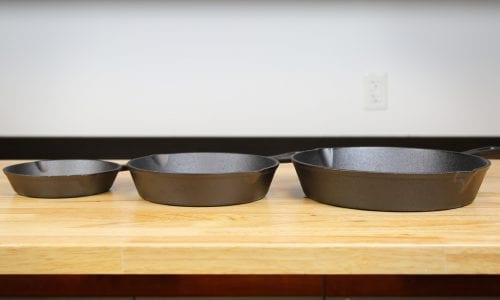The Best Grater

Our Review Process
Don't Waste Your Money is focused on helping you make the best purchasing decision. Our team of experts spends hundreds of hours analyzing, testing, and researching products so you don't have to. Learn more.
Our Picks For The Top Graters
- 1. Utopia Kitchen Hexagonal-Sided Anti-Skid Grater
- 2. KitchenAid Gourmet Rust Resistant Non-Skid Grater
- 3. Deiss Citrus Zester & Cheese Grater
- 4. Spring Chef Wide-Handle Zest & Grater
- 5. Cuisipro Stainless Steel Boxed Grater
- 6. Microplane Dishwasher-Safe Fine Grater
- 7. OXO Manual Slim Box Grater
- 8. K BASIX Ergonomic Non-Slip Grater
- 9. Spring Chef All-In-One Quick Prep Grater
- 10. Raniaco Non-Toxic Kitchen Grater
- 11. Microplane Ultra-Sharp Rust-Free Zester Grater
Most graters offer between two and four sides, but not this model. It impresses with a total of six sides that each feature a different thickness. You'll be able to quickly grate fine parmesan to top off your soup and then switch to slicing radishes for your salad.
Most VersatileThe rubber handle on this grater allows for maximum control when grating cheese and other ingredients.
There's no need to grab a plate when you opt for this grater. It comes with a detachable storage container that allows you to grate your favorite cheese right into the cup. Of course, if you'd like to use your grater on a plate, cutting board or counter, it's also outfitted with a non-skid bottom.
Multiple Color OptionsYou'll find this grater comes in a choice of red, aqua, black and pomegranate.
Individuals who prefer a handheld grater will love this model. The stainless steel blade is not only durable, but it also resists rust. The grater is lightweight and has a non-slip handle. So, you won't have any trouble holding it over your plate or frying pan while you add a little Parmesan cheese or lemon zest to your dish.
Top Handheld GraterYou'll love this handheld grater's ability to quickly add a touch of flavor to your favorite dish.
Not only does this grater stand out among its competitors as our No. 1 pick, but it's also easy on the pocketbook. This stainless steel grater has four sides for grating everything from carrots to cheddar cheese. The non-slip base keeps the grater in place, while also protecting your countertop from being scratched. The unit is also dishwasher safe...
Budget-Friendly ChoiceThis low-cost grater doesn't sacrifice on quality with its stainless steel design and non-slip base.
Buying Guide
Graters are sometimes called shredders, choppers or slicers. Their main job is to quickly cut up various foods into smaller pieces without much effort, so they either melt faster in a recipe or are more bite-sized and easier to chew. The two biggest graters on the market are the box grater, which sits firmly on a countertop or a cutting board, and a handheld grater, which can be suspended over a frying pan or plate of food.

Whether you are a professional chef or an enthusiastic home cook, you’ll want to have a grater on hand. Before you select a model for your kitchen, read this guide to gain a better understanding of what you should look for while you shop.
Take a look at your specific needs to determine whether a box grater or a handheld grater would be a better fit. Box graters are meant to rest on a kitchen counter. They can withstand the pressure of shredding hard vegetables, like carrots and cabbage. Handheld graters work better for individuals who like to add a little extra flavor to their recipe or who want to garnish their plate with a little color before serving it to a guest.

Once you know the type of grater you’re interested in, you can move on to examining the material the grater is made out of. While there are some graters on the market created out of wood and bamboo, stainless steel is the most commonly used material. The benefits of stainless steel include durability, easy cleaning and a resistance to rust.
Check graters for non-slip handles and bases. The Spring Chef Box Grater has both, and this ensures that your grater won’t go flying when you’re busy grating that garlic.
See how many different types of cuts you can get with the shredder you’re interested in. Some graters only has one blade with teeth that cut fruits, vegetables and herbs nice and fine, but the Deiss Citrus Zester & Cheese Grater has four blades that offer a coarse, medium and fine cut, along with a bonus slicer.
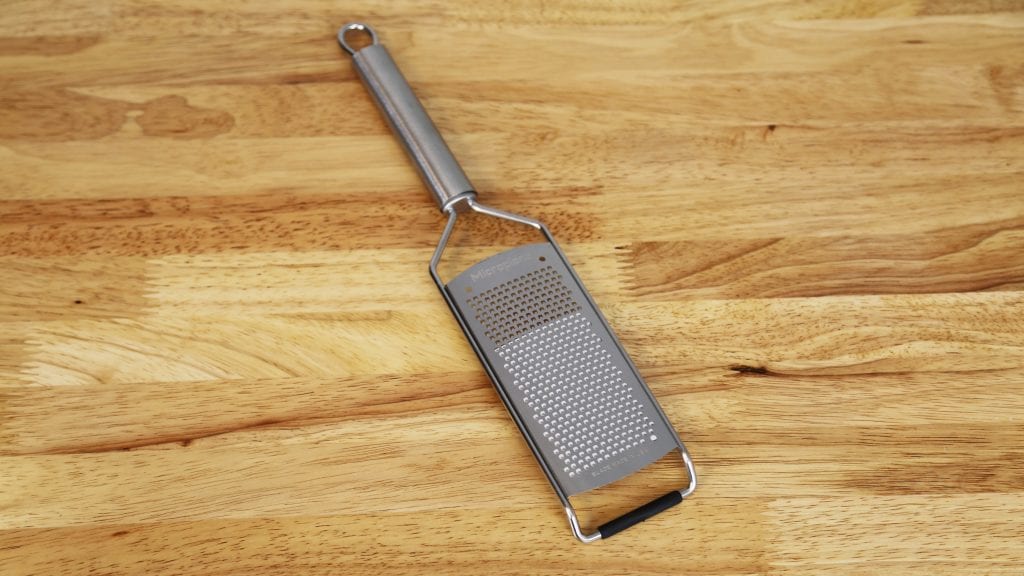
Look for any extras that the grater may offer. For example, some graters have a detachable base that is designed to grate ginger. Other models come with an attached measuring container, while others offer a small detached storage container. You can also get graters with some citrus juicers.
What to Look For
- Always be cautious when using a grater, as the product can cut through skin if you accidentally run your finger or knuckle over the teeth.
- Since graters have sharp teeth, it is important to store them out of the reach of small children. A top cabinet is a good choice. If you need to use a bottom cabinet, they make child locks you can use until the little one grows up enough to understand the danger involved in using the grater.
- If you have a hard time holding on to a grater, look for one with a large or wide handle. That will allow for a better grip.
- While it is important to verify with the product label, most graters are dishwasher safe. Of course, they can also be washed and rinsed by hand if need be.
- Graters also help in preparing food for certain pets. For example, guinea pigs eat raw vegetables. It’s easier for them to munch on carrots, celery and zucchini after you’ve used the slicer on your grater.
- You don’t just have to reserve your grater for food. You can also use it to shave down old soap to make new bars.
- Check to see if the company offers a satisfaction guarantee or a warranty, as these are good indicators that the company stands behind its products. Believe it or not, some companies even offer a lifetime guarantee!
- In addition to a warranty, look for any special recommendations, such as a recommendation from Cook’s Illustrated. That way, you know experts have tested the product and found it to be satisfactory.
- When comparing grater prices, it is important that you only compare like units and that you take into consideration any extras the grater may offer. For example, the Spring Chef Box Grater is cheaper than models that come with an additional ginger grater. Additionally, when comparing the handheld graters, you’ll find the Deiss Citrus Zester & Cheese Grater is slightly cheaper than other graters because the blade and handle are much thinner.
More to Explore
Just like most inventions, necessity led to the creation of the first grater. Back in 1540, many French citizens began avoiding meat, due to an increase in diseases among meat products. As a result, more and more cheese was being produced — so much so that townsfolk couldn’t consume it fast enough. The hardened cheese then became a big pain to try and cut up.
A man by the name of François Boullier designed the first cheese grater, and he made it out of pewter. Today, most graters are made from stainless steel. If you ever want to take a look at the first grater model, all you have to do is visit the Musee de Havre in France.
Graters didn’t catch on in the United States until the 1920s when Jeffrey Taylor decided to create a model to shave the hard cheese he had in his store. This was during the Great Depression when food wasn’t as plentiful.
At present, there are many different types of graters to choose from. Each has a different use. Graters with larger teeth are better for creating carrot slices for coleslaw or salads, while graters with finer teeth work better on lemon zest and ginger. There’s even a grater in Jamaica that doubles as a coconut grater and a musical instrument.




